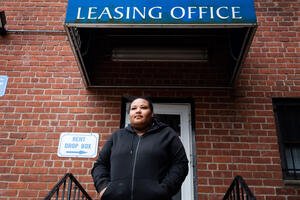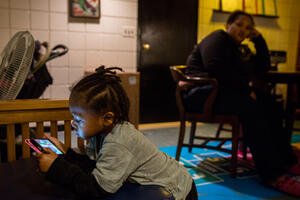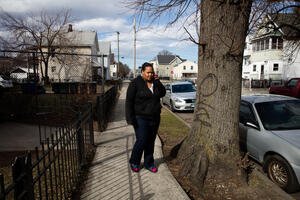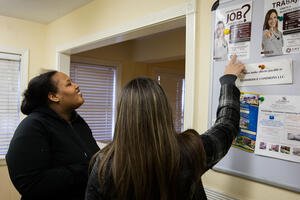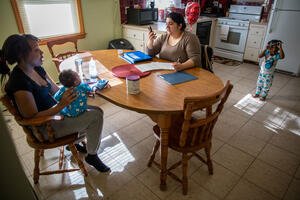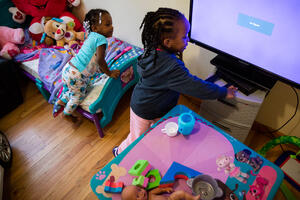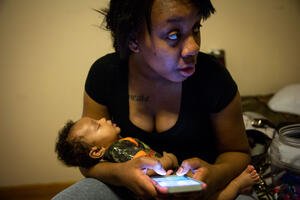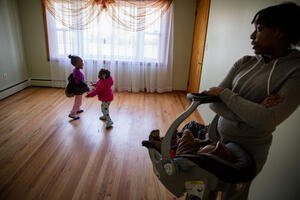Protecting Families: A Photo Story About Supportive Housing
Photography by Lydia Thompson & Writing by Alexandra Tilsley
Family stability and housing stability go hand in hand to influence a child’s healthy development.
Yet, across Connecticut, approximately 4,000 children live with foster families or in other placements through the Department of Children and Families (DCF). Most of these cases arise from neglect, with housing as a common contributor. Living in unsafe or unstable housing can burden parents mentally and physically, sometimes so much that they can’t properly care for their children.
Many Connecticut families who have lost their children because they lack stable housing are referred to The Connection, a nonprofit human services organization. Since 1998, The Connection has offered a supportive housing program, funded by DCF, to improve family stability.
The Connection’s Supportive Housing for Families program focuses not just on getting a family in a home, but on providing the wraparound services—from mental health counseling to substance use treatment to educational support—that can get children out of state care and back into the home, ultimately leading to better lifelong outcomes. The program directors see it not as a housing program, but a child welfare program, with housing as the intervention.
Jaquella Smith, 22, has been living at the YMCA shelter in Bridgeport since September. Until the summer, she had her own apartment, where she lived with her son, Micheal, but when her hours at work got cut, she could no longer pay her rent and started moving from place to place, sleeping on friends’ couches. Eventually, on the advice of her aunt, she moved into the shelter. She’s eager to find her own place again. “It’s been hard in the shelter,” she said. “Some days are rough, but you get over it.”
The YMCA shelter in Bridgeport houses about 12 families, including men, women, and children. Families have their own rooms, but they share bathrooms, and personal space is limited. Jaquella says the best thing about having her own apartment will be having her own space and being able to give Micheal his own room.
In 2016, around 10 percent of Connecticut’s homeless population, including 13 percent of homeless children in families, could be found in greater Bridgeport. The area is home to 7 percent of the state’s population. Bridgeport was once the state’s manufacturing center, and its postindustrial economy is still emerging. Twenty-three percent of the city’s 145,000 residents live in poverty, and only 17 percent hold a bachelor’s degree or higher.
Micheal lives with Jaquella at the shelter and attends day care during the day. The shelter’s community room has a few books and toys, but Jaquella also lets 2-year-old Micheal play games on her phone to keep him entertained. Jaquella is hoping to find a two-bedroom apartment so Micheal can have his own space.
Jaquella and Micheal were referred to The Connection after Micheal’s father brought Micheal with him to a court hearing, and someone reported it to DCF. Micheal splits his time between his two parents, but because his father is living on other people’s couches, Micheal lives with Jaquella at the shelter.
Jaquella’s car is in the shop, and her hours at work are limited, so she spends a lot of time hanging out around the shelter, looking for jobs or apartments on her phone. “I’m a boring person,” she said.
Jaquella’s Connection case manager, Adneris Santiago, accompanies her on visits to potential apartments. At the first apartment, the landlord never shows up, even though Jaquella had made an appointment. It’s the third time this has happened since Jaquella and Adneris started looking at apartments just over a month ago. At the second apartment, Jaquella and Adneris wait half an hour for the landlord, who is hesitant to show Jaquella the apartment because he is worried she won’t be able to pay her bills.
The Supportive Housing for Families program subsidizes its clients’ housing until the client is financially stable and can be self-sufficient. Clients are asked to pay approximately 30 percent of their income, and The Connection pays the rest. Payments fluctuate with family income. The Connection’s case managers also ensure clients aren’t overhoused. The goal is that the transition to paying the whole rent cost will be manageable once families are done with the program and have a steady income and a stable home. Still, the landlord at the complex Jaquella and Adneris are visiting needs some convincing before showing Jaquella the apartment.
As Jaquella and Adneris wait for the landlord, Adneris notices a poster advertising jobs for certified nursing assistants (CNA). Jaquella is a CNA, but has been struggling to find enough work to make ends meet. Case managers set goals with each client, and one of Jaquella’s goals is to find a second job. Though she leaves without an apartment, she writes down the phone number on the poster and promises to apply for the job when she gets back to the shelter.
“We want to make sure that when they sign the lease, they can keep up with their bills,” Adneris said.
In Connecticut, family homelessness is not limited to Bridgeport. The waiting list for supportive housing is more than 800 families long. When The Connection’s Supportive Housing for Families Program started in 1998, it had three sites, had four case managers, and served 35 families. Now, there are eight offices—and six other agencies subcontracted to provide the same supportive housing program—and has 45 case managers serving about 600 families a year.
Case managers typically work with families for 12 to 18 months, though the duration can vary. The goal is to stick with families until their DCF case is closed, they are stably housed, and they have a steady income. Housing is the first priority. Although many families have other needs—often around employment, substance abuse, or mental health—The Connection believes you can’t really focus on those other problems until you have stable housing.
For many clients, 12 to 18 months of support and the relationship with their case manager helps them get their lives on track. Occasionally, however, clients fall back into old patterns and lose the stability they’ve worked hard to find. If that relapse leads to further DCF involvement, the Supportive Housing for Families will take the family on again.
Dee, 19, whose name has been withheld to respect her privacy, and her two young children recently moved into an apartment in New Britain, thanks to help from her case manager, Lauren Caesar. Dee has been living at her mom’s house with her older child, Jenesis, but she had a bad relationship with her mom, and eventually her mom kicked her out. “I’m not going to lie, I was disrespectful,” she said. “I was in and out of detention a lot, and she didn’t really want me in the house anymore.”
Dee lived with her grandmother for a short time before moving into her own apartment, which she paid for by working at McDonald’s while attending high school. Shortly after moving in, however, she got pregnant again and said the smell of McDonald’s started making her sick. She quit her job, moved out, and started living in different motels until a counselor from The Connection’s Supportive Housing for Families program called her in November.
Case managers conduct monthly inspections of a family’s house to make sure they’re maintaining good living conditions. Many families in the program have never had their own home, so case managers help them learn the responsibilities that go with having a house or apartment.
Because she’s already in a home, Dee’s goals are different from Jaquella’s. One of Dee’s early goals was finding a job, but she did that quickly and now works at Stop and Shop.
“She was applying for jobs when she was in the hospital and had just had her baby,” Lauren said.
Now, Dee’s goals include finding day care for her children, getting her license, and getting her GED. Lauren is helping Dee work through the day care paperwork and has already helped her get into driver’s school. When she’s not working, driving, or watching the kids, Dee, who dropped out of high school when she lost her housing, studies for the GED. She hopes to get her GED by April, go to college, and become a registered nurse.
Since she moved out, Dee says her relationship with her mom has improved drastically. Now, her mom regularly drives up from Waterbury, about half an hour away, with Dee’s 3-year-old sister. Dee’s grandmother also comes by to help watch the kids while Dee is at work or driving school. The Connection emphasizes building strong family or community relationships to ensure clients have built-in support once their case manager leaves.
Jenesis and Erica, Dee’s sister, are practically sisters themselves. Erica, who Jenesis calls Aunt Honey, is just a year older than her niece, and the two lived together for almost two years before Dee moved out with Jenesis. Dee’s mom has talked about moving a little closer to New Britain, but Dee is happy with the balance of independence and family support.
“I like it here,” Dee said. “It has three bedrooms, it’s big, it’s a nice neighborhood. And I don’t know anybody, so it’s peaceful.”
Two-month-old Jeremih has been having trouble keeping food down. Dee says he throws up all the time, even though she’s tried many different formulas. Lauren is helping Dee navigate the process of scheduling doctor’s appointments and buying formula using Women, Infants, and Children and Supplemental Nutrition Assistance Program benefits.
Supportive Housing for Families helped Dee furnish most of her home—it provides the basics clients need to feel at home—but the living room is still a work in progress. Dee wants a couch, but she’s having trouble finding one that will fit through the door. Lauren has given her a gift card to a furniture store, so she, her mom, and her kids, are heading out to look for the right couch.
“They helped with the mattress, the crib, the Bob’s Furniture gift card, basically everything.” Dee said. “Lauren has helped me a lot. She changed me. Without all of this, I think I would have been lost.”
